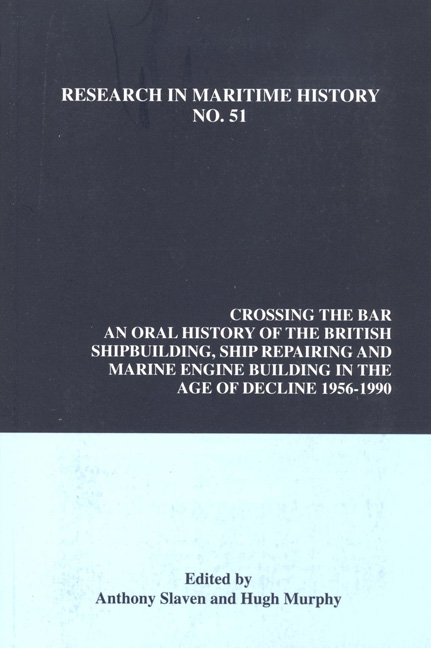 Crossing the Bar
Crossing the Bar Book contents
- Frontmatter
- Contents
- About the Authors
- Dedication
- Preface: A Shipbuilding Libretto
- Introduction
- Interviews
- Lower Clyde
- Upper Clyde
- The Tyne
- The Wear
- Barrow-in-Furness
- The South Coast
- The Humber
- Belfast
- British Shipbuilding Industry Officials
- The Trade Unions
- The Civil Servants, Board of Trade, Shipbuilding Enquiry Committee, Shipbuilding Industry Board, Ministry of Technology, Department of Trade and Industry, Department of Industry
- The Politicians
- Interviews British Shipbuilders Plc
- Conclusion
- Select Bibliography
Interviews British Shipbuilders Plc
- Frontmatter
- Contents
- About the Authors
- Dedication
- Preface: A Shipbuilding Libretto
- Introduction
- Interviews
- Lower Clyde
- Upper Clyde
- The Tyne
- The Wear
- Barrow-in-Furness
- The South Coast
- The Humber
- Belfast
- British Shipbuilding Industry Officials
- The Trade Unions
- The Civil Servants, Board of Trade, Shipbuilding Enquiry Committee, Shipbuilding Industry Board, Ministry of Technology, Department of Trade and Industry, Department of Industry
- The Politicians
- Interviews British Shipbuilders Plc
- Conclusion
- Select Bibliography
Summary
The portents leading to the nationalization of the British shipbuilding industry in July 1977 through British Shipbuilders Plc were not propitious. Despite the growing market challenges facing the industry, the period from 1974 to 1977 was characterized by internecine political bickering over the nationalization of the British aircraft and shipbuilding industries in Parliament. The debate soon descended into an ideological dogfight that unduly delayed the process of nationalization under two Labour governments. It also had a serious impact on the shipbuilding industry's ability to survive against withering international competition. On the industrial front, the road to nationalization was not aided by the shipbuilding firms which through their trade association, the Shipbuilders and Repairers National Association - formed in 1967 to replace the old Shipbuilding Employers Federation, Shipbuilding Conference, Dry Dock Owners and Repairers Central Council, and National Association of Marine Engineers - virulently opposed state control. Conversely, the shipyard trade unions whose members ‘ jobs were at stake were almost messianic in their desire for nationalization. The delay resulted in firms paralyzing development or investment plans and maintaining very high levels of manning.
By the time nationalization actually took place, however, most firms in the industry were unprofitable and faced an uphill fight to survive. Owing to the long delay in nationalizing the industry, the Organising Committee Chief Executive Designate, the Canadian lawyer and shipbuilding general manager (Cammell Laird), Graham Day, resigned, and Mike Casey, a career civil servant, took his place. British Shipbuilders’ first Chairman was Admiral Sir Anthony Griffin, a former Controller of the Navy and Third Sea Lord. Griffin resigned in 1981. Prior to nationalization, the ship repair industry was excluded by an amendment to the original Bill when it was before Parliament. Only after nationalization were six additional ship repair companies acquired by British Shipbuilders Plc.
- Type
- Chapter
- Information
- Crossing the BarAn Oral History of the British Shipbuilding, Ship Repairing and Marine Engine-Building Industries in the Age of Decline, 1956-1990, pp. 193 - 195Publisher: Liverpool University PressPrint publication year: 2013
